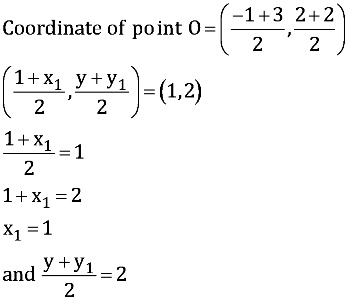Question 4:
The two opposite vertices of a square are (− 1, 2) and (3, 2). Find the coordinates of the other two vertices.
Answer:

Let ABCD be a square having (−1, 2) and (3, 2) as vertices A and C respectively. Let (x, y), (x1, y1) be the coordinate of vertex B and D respectively.
We know that the sides of a square are equal to each other.
∴ AB = BC

We know that in a square, all interior angles are of 90°.
In ΔABC,
AB2 + BC2 = AC2

⇒ 4 + y2 + 4 − 4y + 4 + y2 − 4y + 4 =16
⇒ 2y2 + 16 − 8 y =16
⇒ 2y2 − 8 y = 0
⇒ y (y − 4) = 0
⇒ y = 0 or 4
We know that in a square, the diagonals are of equal length and bisect each other at 90°. Let O be the mid-point of AC. Therefore, it will also be the mid-point of BD.

⇒ y + y1 = 4
If y = 0,
y1 = 4
If y = 4,
y1 = 0
Therefore, the required coordinates are (1, 0) and (1, 4).
Latest Govt Job & Exam Updates: